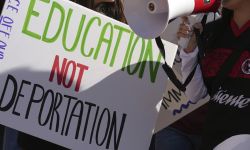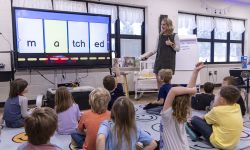As more students head back, here’s what we now know (and still don’t) about schools and COVID spread

Two months ago, Ashish Jha, the dean of Brown University’s School of Public Health, was something of a school reopening skeptic. In places with relatively high COVID rates, like Florida and Texas, K-12 school buildings should stay shuttered to protect the health of teachers, students, and their communities, he argued.
Now, his view is changing.
“The evidence so far suggests that we can likely open schools — especially K-5 — pretty safely in most parts of the country,” he said, as long as those schools take precautions like requiring masks. “I’m getting slowly but surely persuaded that I may have been too cautious.”
That’s because where schools have reopened, things have gone relatively well, as least as far as scientists and public health officials can tell right now. Many European countries have reopened schools with apparent success, too. That consensus is pushing more schools to reopen buildings, even as case counts rise across the country, and is driving increasingly confident claims that there is little or no relationship between schools and COVID spread.
It’s also true, though, that the existing evidence is still limited, and some epidemiologists say it’s simply too soon to reach firm conclusions.
There has been no effort from the federal government to systematically track school openings and COVID outbreaks. That means we are often relying on data from those who volunteer it, and lack good information about how schools that have reopened might differ from those that have not.
Then there is the inherent difficulty of the project: It’s tough to isolate the effect of a single factor like school reopening on community COVID spread, particularly when testing data is also limited.
That tension — more data, but all of it limited — is at the heart of the school reopening debate right now, several epidemiological and education researchers suggest. Jha, for one, is optimistic.
But, he cautions, “The strength of the evidence here is shaky.”
The case for school reopening
As more and more schools across the country have reopened their buildings, many local officials say they haven’t seen a strong connection to COVID spread in their communities and that outbreaks have been relatively rare, unlike what’s happened at many universities.
In New York City, random tests of over 16,000 staff members and students turned up only 28 positive results.
In Colorado, 43 schools — out of more than 1,900 in the state — have experienced outbreaks in which public health officials documented transmission within the school building since schools began reopening in late August.
Nationally, among over 1,000 schools voluntarily reporting data, test positivity rates are very low: 0.14% among children and 0.36% among staff.
“A lot of people expected, oh, we would have 100 cases of COVID day one — and places aren’t seeing that,” said Preeti Malani, the University of Michigan’s chief health officer, referring to K-12 schools. “They’re not closing down. They’re able to find a way to continue on.” That’s pushed her to believe that schools generally can and should reopen.
A national study of childcare providers showed that those who continued working were just as likely to say they had contracted COVID as those who stayed home.
Reopenings seem to have gone well in many European countries, too. In Germany, one of the most rigorous studies on the question found reopening schools was actually linked to lower, not higher, rates of COVID spread.
It’s also clear that children are less likely to suffer severe symptoms from COVID, and deaths among children are very rare (although Black and Hispanic children have been disproportionately affected).
A recent overview of research from around the world concluded that “widespread transmission can occur among school-age children, but that there is very little evidence, at least in the context of relatively low community transmission, that schools have been a driver of transmission.”
Jha says the growing collection of data points has swayed his opinion. “I’ve got eight or 10 pieces of data, every one of which is super weak — but they’re all pointing in the same direction,” he said.
There is also largely undisputed evidence that school closures do major harm to students, academically and otherwise.
“Not only are there benefits to being in school, there are also risks of not being in school,” said Sarah Cohodes, an education researcher at Teachers College at Columbia University.
Instances of child neglect have likely gone unreported. Children are more socially isolated. And they have missed months of in-person instruction, with uneven remote learning. One recent study out of Belgium, using actual student test scores, showed sharp declines in learning.
“The evidence in terms of learning is clear — that learning is better in person, especially for younger children,” said Cohodes, who has compiled research on a number of aspects of COVID and education.
Alicia Riley, a postdoctoral scholar in epidemiology at UC San Francisco, goes further, noting that some prior research has even found that more education helps people lead longer lives. In other words, keeping schools closed may have its own long-term deleterious effects on health.
“Our concepts of safety — we’re only calculating in the COVID risk,” she said. “But if we’re thinking about the real long-term health harms, schooling is protective for health.”
The case for reopening caution, and better data
Some epidemiologists view the same data with more wariness.
“I think it’s premature to say that school reopening has been successful. For a start, it’s an ongoing process linked to what’s happening in the community generally,” said Zoë Hyde, a senior research officer at the University of Western Australia. “If community transmission rises, then you will see outbreaks in schools. This has become very apparent in Europe as they battle their second wave.”
A number of experts are concerned that we’re not getting a full picture because of incomplete testing. “While we know we are only seeing part of ‘the iceberg’ of all infections, we don’t know exactly how much of that iceberg we are seeing,” said Kim Powers, an epidemiologist at the University of North Carolina.
That may be particularly concerning with children, who are often asymptomatic and thus less likely to be tested. “It’s quite likely that we’re not spotting a lot of the infections which are occurring in children,” said Hyde.
“If we’re just doing symptomatic testing and we’re only counting cases in which kids are symptomatic, it’s kind of impossible to trace this adequately and to really understand what’s going on,” agreed Riley.
Meanwhile, there’s general agreement that existing data is insufficient, and that it can be difficult to generalize the conclusions.
The tracker of COVID test results from schools being compiled by Brown researcher Emily Oster and others, for instance — the most comprehensive national database available — is only able to include the fraction of public schools that voluntarily provide information, with results that may not be representative. The study of childcare workers was also based on an online survey that the researchers described as “not fully representative.”
Other international research acknowledges that it simply cannot disentangle the effect of school reopenings from many other factors. Pinning down how outside factors — low rates of community spread, many students staying home, mild temperatures allowing for open windows and good ventilation — might have contributed to success stories could guide school officials elsewhere.
There is also some evidence on the other side of the ledger, though it comes with its own caveats. Data compiled by the American Academy of Pediatrics show that the number of children with new COVID cases has been rising slightly in recent weeks, though that doesn’t mean cases are necessarily linked to schools.
Idaho has seen upticks in cases among children and adults, with the governor saying reopened schools has been one factor. In suburban Salt Lake City, a school district saw cases rapidly emerge at some of its schools, forcing a shutdown of three high schools and a middle school. In different parts of the country, reported COVID cases in schools or among school staff have continued to tick up, though the numbers appear relatively low overall.
A recent Swedish study found evidence that COVID infection rates were higher among teachers (and their partners) whose schools didn’t close this spring, compared to teachers whose schools did close. (Notably, mask use in schools did not appear to be widespread at the time.)
“The overarching message is that the evidence is still evolving and pretty scant,” said Rebecca Haffajee, a health policy researcher at RAND.
Meanwhile, reopening buildings right now comes with its own often unacknowledged trade-offs. Since many districts are still allowing students to learn from home, and some only allow students in a few days a week, teachers have had to divide their attention between students who still learn virtually and those who are in person. It also means time and energy is being spent on building safety rather than improving the online instruction that many students will still rely on.
Ultimately, there is widespread agreement among experts that more and better data is needed to help school leaders make decisions.
Cohodes described it as “absolutely ridiculous” that researchers have been left trying to collect data on their own. “The federal government should have set out guidelines for collecting this and worked with state departments of education,” she said.
“All of this is frustrating to me because we’re in such a weak data zone and we should have much better data,” said Jha.
Just this week, though, Education Secretary Betsy DeVos described this as not her job. “I’m not sure there’s a role at the department to collect and compile that research,” she said.
Erica Meltzer contributed reporting.
Michigan Education Watch
Michigan Education Watch is made possible by generous financial support from:
Subscribe to Michigan Education Watch
See what new members are saying about why they donated to Bridge Michigan:
- “In order for this information to be accurate and unbiased it must be underwritten by its readers, not by special interests.” - Larry S.
- “Not many other media sources report on the topics Bridge does.” - Susan B.
- “Your journalism is outstanding and rare these days.” - Mark S.
If you want to ensure the future of nonpartisan, nonprofit Michigan journalism, please become a member today. You, too, will be asked why you donated and maybe we'll feature your quote next time!






